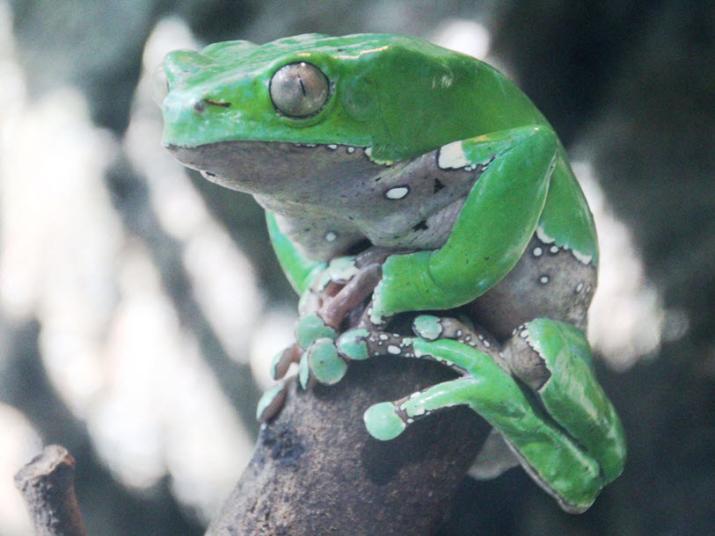
Traditional medicines are usually taken from the surrounding environment. In addition to herbs and plants, some animals may be used. For example, native tribes in the Amazon have used secretions from Phyllomedusa bicolor, or the green monkey frog, to treat a variety of ailments.
Published November 30, 2016, last updated on October 12, 2017 under Voices of DGHI
By Clay Jones, 1st-year Master of Science in Global Health candidate
After a few months of classes here at the Duke Global Health Institute, I can semi-confidently tell you that the biggest target regions of global health projects are low and middle income countries.
Rural areas in these countries are of particular interest to us global health almost-professionals because these areas can be incredibly remote—painfully far from where advancements in medicine, cell phone service and modern technology have spread.
Meditate on this thought for a moment: Without even an inkling of knowledge regarding what we westerners call “medicine" or “modern society,” organized human life has survived, somehow, without pills, hormone therapy, IV drips, hospitals, surgery rooms, cars, fast food restaurants, grocery stores, smartphones, universities and five-shot espresso lattes.
How incredible is that?
In these isolated communities, human life has subsisted on the land with no outside help. Beliefs and knowledge covering a variety of aspects of the human life have been passed down from generation to generation in these communities. Spirituality and the creation of the universe, what plants to use for tea when your child has a tummy ache, how to hunt and manage herds for food and manual treatments for body aches—all of these are examples of customs passed down from elders to children.
Traditional Healers Are Integral to Many Cultures
In many rural, low income communities, people possess masterful knowledge of such important topics. Some are herbalists, midwives or even family members. Others are spiritual healers, referred to in the west as "medicine men" or “shamans.” Shamans, herbalists and other healers are the wisest people in the community with regard to the healing arts outside of biomedicine. They are often the first point of contact for ill people and serve as spiritual counselors for their communities.
When a community member visits a healer because of illness, treatment can range from a prescription of herbs to a spirit cleansing ceremony. Because of this, traditional views of medicine are often inseparable from spirituality and connection with the divine, the universe or higher powers. Afflictions are often deemed a result of spiritual possession or an imbalance of body energies.
Shamanic and traditional beliefs and practices still exist in the world today and are quite prevalent in low and middle income countries. From Amazon rainforest shamans in Peru to religious healers in Kathmandu to African herbalists, traditional healing practices and beliefs weave into the fabric of a country’s culture. These beliefs and traditions are ingrained in communities and are an important aspect of their health-seeking behaviors, culture and collective psychology.
Traditional and Modern Practices Can Co-Exist Peacefully
If we as global health researchers want to do the most good in the areas which we work, we should not ignore these ideals of healing; rather, we should make efforts to understand and accept these practices. In many areas with increasing access to biomedical care, community members continue to seek traditional healers in addition to western treatment, or sometimes even before visiting a clinic.
Nepal is a great example of this. Despite having some increased access to psychiatric and mental health care resources after the earthquakes, many Nepali continue to see traditional healers in combination with community mental health care workers.
The spread of western medical ideals through global health practice, without a doubt, has helped the people of the world. People in many remote communities who once had no access to medication can now access numerous resources for treating preventable diseases. Resources are growing in these areas for mental health care, antiretroviral and antimalarial treatment, maternal and child care and other preventable illnesses like diarrheal diseases that sometimes are not successfully treated with traditional medicine.
With powerful science behind these treatments, it’s easy to forget that healing systems have already been in place for many years in many areas.
We Have a Lot to Learn from Traditional Practices
While doubts remain about whether and how some traditional healing practices work, some of these practices have been proven effective and have even been integrated into western society. You don’t have to look very far to find examples: acupuncture, the creation of the malaria prophylactic artemisia, or even the use of chamomile tea for relaxation. All of these practices have roots in traditional medicine, and further research should be pursued so that we can find what works and what does not.
It is imperative that the global health community not cast these practices by the wayside, as many of them are effective for some populations and are ingrained in the cultures in which we work. Being open to learning and researching traditional medicine can potentially open up doors for the health community as a whole; showing us new healing methods we never thought possible.
If we can rise above the common western stigmas that accompany traditional practices (“witchcraft," "quack medicines," etc.), we can then learn about these systems of healing and how they work. This cross-cultural learning can facilitate an incredible amount of new knowledge, leading to new treatments for illnesses and a greater collaboration between non-western and western healers.


